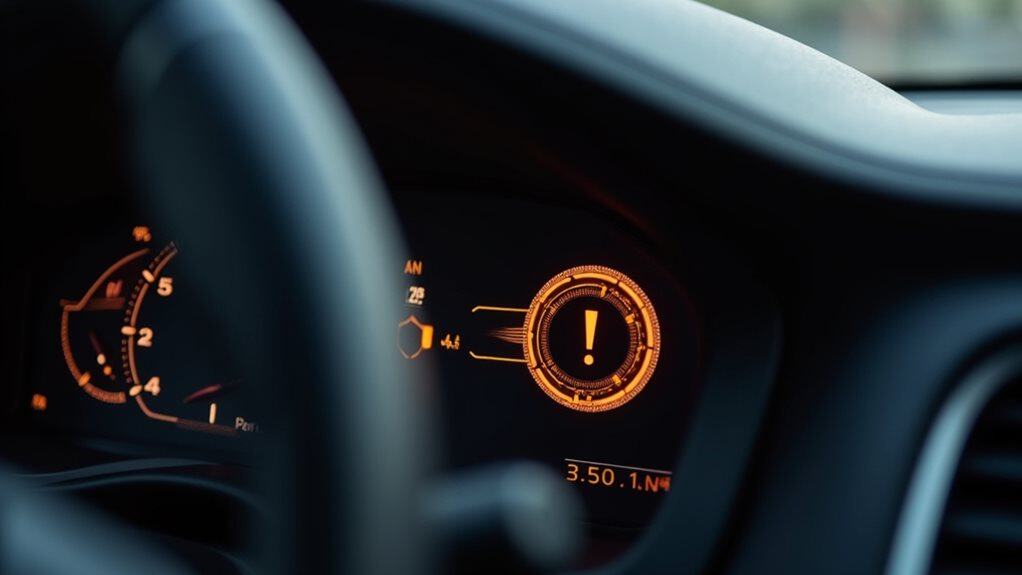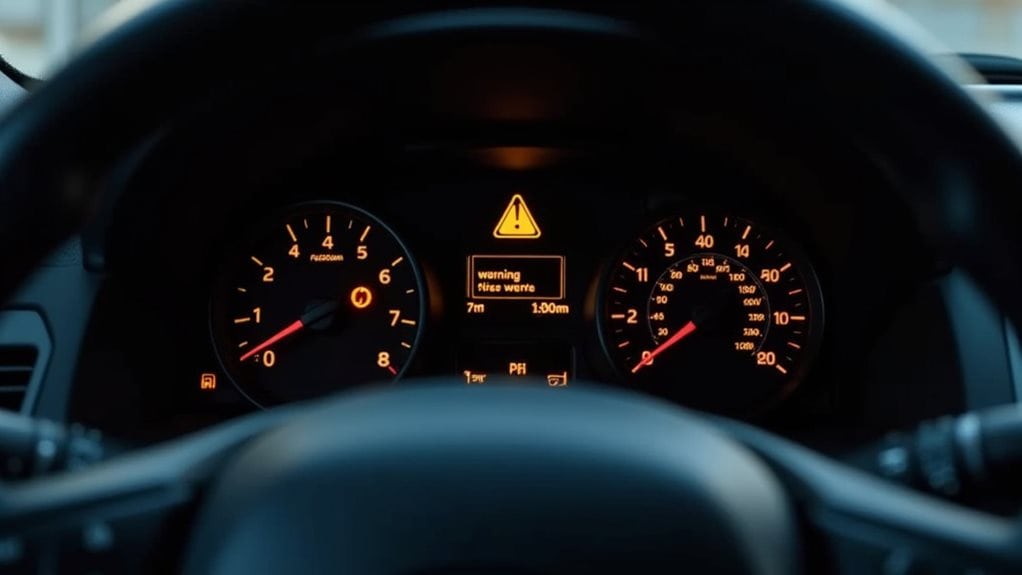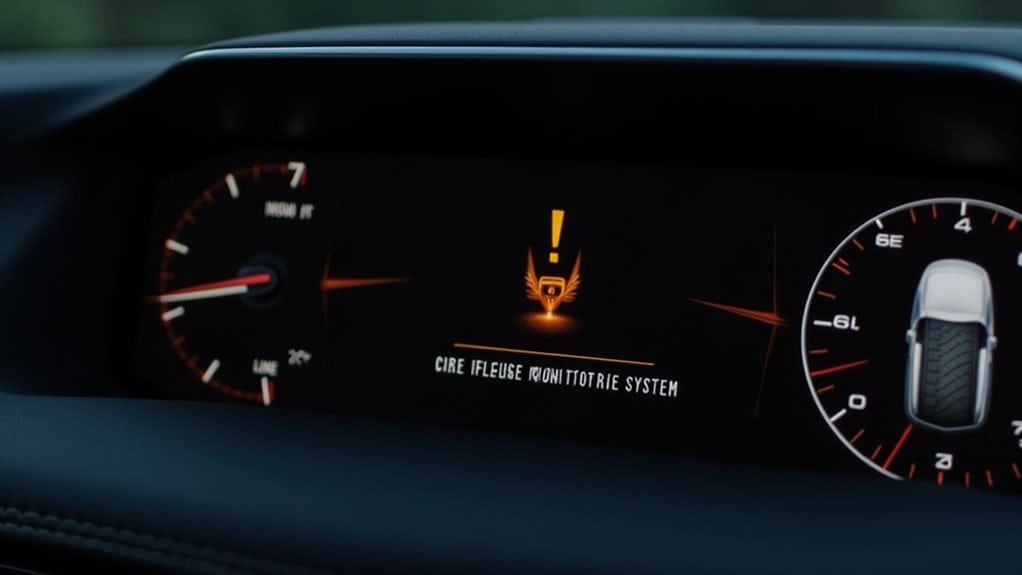When you see a Service TPM warning light, it means your vehicle’s Tire Pressure Monitoring System needs attention. This safety system uses sensors to track tire pressure and alerts you when levels are unsafe. Common triggers include low tire pressure, faulty sensors, or dead sensor batteries that last 5-7 years. While you can often resolve the issue by properly inflating your tires, persistent warnings may indicate deeper system problems that require professional diagnosis. Understanding your TPMS’s specific features will help you maintain ideal tire safety.
Quick Tips
- Service TPM means Service Tire Pressure Monitor, a warning system that alerts drivers when tire pressure is dangerously low or high.
- The warning typically appears as a horseshoe-shaped symbol with an exclamation point on your dashboard’s display panel.
- TPMS uses sensors to monitor tire pressure continuously, becoming a mandatory safety feature in U.S. vehicles after 2007.
- A solid TPM light indicates low tire pressure, while a flashing light followed by steady illumination suggests system malfunction.
- Most TPM warnings can be resolved by properly inflating tires or performing a system reset through manual or automatic methods.
Understanding Service TPM Warning Lights

When your vehicle’s Service TPM warning light illuminates, it’s essential to understand what this crucial safety indicator is telling you about your Tire Pressure Monitoring System (TPMS).
Common triggers include low tire pressure, faulty sensors, recent tire rotations, or dead sensor batteries. An issue with the TPMS can also lead to persistent warning lights that indicate further diagnostics may be necessary.
You’ll notice either a constant or flashing warning light, which may appear as a symbol or message on your dashboard. The light typically appears as a horseshoe with exclamation in your instrument panel.
The Essential Functions of TPMS Technology
Tire pressure monitoring systems (TPMS) come in two distinct forms: direct systems that use physical sensors inside your tires to measure pressure, and indirect systems that rely on your vehicle’s ABS sensors to detect pressure changes through wheel rotation patterns.
Your direct TPMS will give you precise, real-time readings for each individual tire, while indirect systems, though more affordable, provide less accurate measurements based on comparative wheel speeds. Additionally, maintaining proper tire pressure is crucial to prevent issues such as engine performance problems that can arise from poor vehicle handling.
Understanding these differences is essential for your safety, as both types work to prevent accidents by alerting you to dangerous tire pressure conditions that could affect your vehicle’s stability and handling. This technology became standard after the TREAD Act made TPMS mandatory for vehicles sold in the U.S. since 2007.
Direct Vs Indirect Monitoring
Understanding the differences between direct and indirect tire pressure monitoring systems helps you make informed decisions about vehicle safety and maintenance.
Direct TPMS uses dedicated sensors in each tire to provide real-time, accurate pressure readings, while indirect systems rely on your vehicle’s ABS sensors to detect pressure changes through wheel rotation patterns.
Direct systems offer greater precision but cost more than indirect monitoring.
Safety Features in TPMS
Beyond the basic monitoring methods, modern TPMS technology incorporates numerous safety features that work together to protect you and your vehicle.
You’ll receive real-time alerts through dashboard displays and warning lights when tire pressure drops, helping prevent dangerous blowouts.
The system also enhances your vehicle’s handling, improves fuel efficiency, and helps maintain even tire wear for ideal safety conditions.
When Your TPMS Needs Attention

When your vehicle’s TPMS light illuminates, it’s essential to determine whether you’re dealing with a simple pressure issue or a more complex system malfunction.
If the light stays on continuously, you’ll need to check for considerably under- or overinflated tires.
However, if you notice the light flashing before remaining steady, you’re likely facing a system malfunction that requires professional inspection. Additionally, it’s important to ensure that your brake fluid system is functioning properly, as no fluid flow can lead to similar warning signals in your vehicle.
Steps to Reset Your Service TPM Light
To reset your Service TPM light, you’ll need to understand three main approaches that vary by vehicle make and model.
You can attempt a manual reset using your vehicle’s TPMS button, which typically requires turning the key to “on” without starting the engine and holding the reset button until you see the indicator flash.
If the manual method doesn’t work, you can try driving at 50 mph for about 10 minutes to trigger an automatic reset, or visit a professional technician who can perform a diagnostic reset using specialized equipment. Additionally, it’s important to ensure that your turn signal relay is functioning properly, as electrical issues can sometimes interfere with system resets.
Manual Reset Process Steps
Resetting your service TPM light involves a series of precise steps that vary depending on your vehicle’s make and model.
You’ll need to turn your ignition to ON without starting the engine, then follow your vehicle’s specific sequence to activate relearn mode.
Trigger each sensor by adjusting tire pressure, and wait for confirmation signals like horn beeps or flashing lights before completing the process.
System Reset Through Driving
While manual reset procedures work well for many vehicles, some modern cars offer a simpler approach through their driving-based reset system.
To activate this automatic reset, you’ll need to drive above 15 mph for up to 20 minutes. Your car’s computer will relearn the sensor positions as you drive, and you’ll receive confirmation through visual or audio signals when the process is complete.
Professional Diagnostic Reset Options
Professional mechanics rely on three primary diagnostic tools to reset Service TPM lights effectively.
These include specialized automotive scan tools that connect to your vehicle’s OBD-II port, TPMS sensor relearning equipment for new tire installations, and advanced diagnostic systems for complex system errors.
You’ll find these tools at authorized dealerships and specialized tire shops, where experts can guarantee proper calibration.
Common Causes of TPMS Malfunctions
Tire Pressure Monitoring Systems (TPMS) can malfunction due to several common issues that vehicle owners should understand.
Low or dead sensor batteries, which typically last 5-7 years, are frequent culprits. You’ll also encounter problems from physical damage, corrosion from road salt, and electromagnetic interference.
Faulty wiring connections between sensors and your vehicle’s computer system can disrupt accurate pressure readings.
Benefits of Maintaining Proper Tire Pressure

Having a properly functioning TPMS alerts you to pressure issues, but maintaining the right tire pressure delivers significant advantages for your vehicle and wallet.
You’ll benefit from improved fuel efficiency, saving up to 3% on gas, while also extending your tires’ lifespan. Proper pressure enhances your safety through better handling, shorter braking distances, and reduced risk of blowouts during emergency maneuvers.
Professional TPMS Diagnostics and Repair
When your vehicle’s TPMS system needs attention, you’ll want to rely on specialized diagnostic equipment and knowledge to guarantee accurate repairs.
Professional tools like the Bartec Tech600Pro and Foxwell TS5000 can read sensor data, program new sensors, and perform thorough system checks.
These tools receive regular updates to support various vehicle models and provide detailed diagnostic reports for precise repairs.
Best Practices for TPMS Maintenance

To maintain ideal performance of your TPMS system, you’ll need to follow a thorough maintenance routine that encompasses regular inspections and proactive care.
You should conduct monthly tire pressure checks, inspect sensors and valve stems for damage, and guarantee proper calibration after tire rotations.
Don’t forget to monitor sensor battery life and replace them every 5-6 years or during scheduled tire replacements.
Wrapping Up
Your vehicle’s TPMS is an essential safety feature that you shouldn’t ignore. By understanding what triggers the Service TPM warning, knowing how to properly maintain your tire pressure, and responding promptly to system alerts, you’ll guarantee safer driving conditions and better fuel economy. Whether you choose to reset the system yourself or seek professional help, keeping your TPMS functioning correctly is vital for your vehicle’s performance and your safety.

